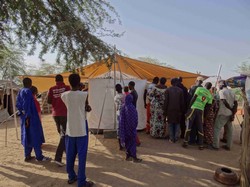Emergency kits to help overcome disaster
Within the European project S(P)EEDKITS(opens in new window) (Rapid deployable kits as seeds for self-recovery) , novel emergency kits were developed for use during emergency response and humanitarian aid. A kit is a well-defined set of equipment that is either used by humanitarian workers or given to the affected population. The project focused on kits that can be easily shipped and rapidly deployed within the first hours of an emergency, hence the focus on SPEED. At the same time, the kits should contain materials and provide solutions that are useful beyond the actual emergency situation. This means that the kits should be able to form the SEED for long-term recovery, potentially via local adaptation/upgrading. The project covered the domains of shelter (providing semi-temporary housing), water (drilling kits), sanitation (easy to deploy toilets for emergency situations), energy infrastructure, medical infrastructure (containerised operation theatre) and deployment support (high-tech tracking capabilities in real time). Emphasis was also put on smart packaging of the kits and on compiling self-explanatory manuals that ensure neutrality in terms of gender and culture. Within each of these domains, the partners worked on ideas and conceptualisation, then early prototypes and eventually field demonstration. The guiding principle was that the kits should be high tech in design (by incorporating the latest technologies and materials), but simple, robust and easy to use. This resulted in several innovative kits, e.g. a Hospitainer (a containerised operation theatre) which was deployed in Syria and Sudan, and also in the Philippines in the wake of Typhoon Haiyan. Elsewhere, novel shelter solutions were demonstrated in a small rural settlement in Senegal, while in Ethiopia and Madagascar field drilling tests were successfully conducted. Eight of the developed kits are now available as commercial products, including a multipurpose shelter unit, a jetting kit for water drilling, raised toilets, a mobile de-sludging device for emptying latrines, a water tower kit and containerised medical infrastructure. The commercialisation has been made possible through project partners and collaboration with external companies. The customers for these novel kits are humanitarian organisations such as Médecins Sans Frontières, Oxfam, UNFPA (United Nations Population Fund) and national Red Cross Societies. S(P)EEDKITS was partially funded by the EU FP7 programme and was coordinated by Centexbel, the Belgian textile centre. It was implemented by a consortium of 15 partners with diverse expertise from six European countries, and also included, apart from research and industry partners, several humanitarian organisations such as Médecins Sans Frontières, The Netherlands Red Cross and the Shelter Research Unit of the International Federation of the Red Cross and Red Crescent Societies. A video(opens in new window) showing a field demonstration in Senegal is available on YouTube.





